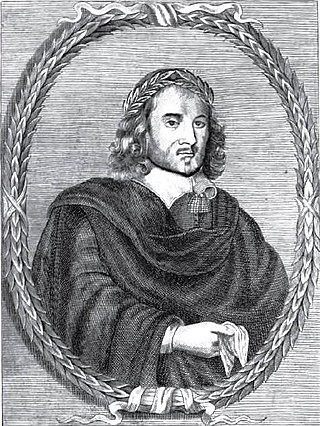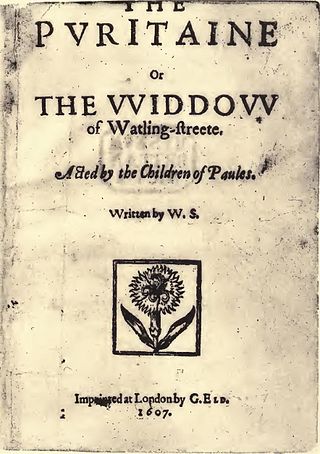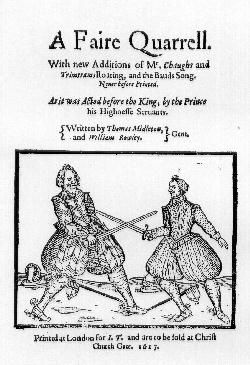Related Research Articles

Thomas Middleton was an English Jacobean playwright and poet. He, with John Fletcher and Ben Jonson, was among the most successful and prolific of playwrights at work in the Jacobean period, and among the few to gain equal success in comedy and tragedy. He was also a prolific writer of masques and pageants.
William Rowley was an English Jacobean dramatist, best known for works written in collaboration with more successful writers. His date of birth is estimated to have been c. 1585; he was buried on 11 February 1626 in the graveyard of St James's, Clerkenwell in north London.
The Birth of Merlin, or, The Child Hath Found his Father is a Jacobean play, probably written in whole or part by William Rowley. It was first performed in 1622 at the Curtain Theatre in Shoreditch. It contains a comic depiction of the birth of the fully grown Merlin to a country girl, and also features figures from Arthurian legend, including Uther Pendragon, Vortigern, and Aurelius Ambrosius.

A New Way to Pay Old Debts is an English Renaissance drama, the most popular play by Philip Massinger. Its central character, Sir Giles Over-reach, became one of the more popular villains on English and American stages through the 19th century.

All's Lost by Lust is a Jacobean tragedy by William Rowley. A "tragedy of remarkable frankness and effectiveness," "crude and fierce," it was written between 1618 and 1620.

The Puritan, or the Widow of Watling Street, also known as The Puritan Widow, is an anonymous Jacobean stage comedy, first published in 1607. It is often attributed to Thomas Middleton, but also belongs to the Shakespeare Apocrypha due to its title page attribution to "W.S.".
The Old Law, or A New Way to Please You is a seventeenth-century tragicomedy written by Thomas Middleton, William Rowley, and Philip Massinger. It was first published in 1656, but is generally thought to have been written about four decades earlier.

A Chaste Maid in Cheapside is a city comedy written c. 1613 by English Renaissance playwright Thomas Middleton. Unpublished until 1630 and long-neglected afterwards, it is now considered among the best and most characteristic Jacobean comedies.

The Roaring Girl is a Jacobean stage play, a comedy written by Thomas Middleton and Thomas Dekker c. 1607–1610.
Anything for a Quiet Life is a Jacobean stage play, a city comedy written by Thomas Middleton and John Webster. Topical allusions suggest the play was written most likely in 1621.
The Spanish Gypsy is an English Jacobean tragicomedy, dating from around 1623. The play was likely a collaboration between several dramatists, including Thomas Middleton, William Rowley, Thomas Dekker, and John Ford. Like Shakespeare's lost play Cardenio, The Spanish Gypsy is an English reworking of the novellas of Miguel de Cervantes, combining two of Cervantes' Novelas Ejemplares into a single drama.

A Trick to Catch the Old One is a Jacobean comedy written by Thomas Middleton, first published in 1608. The play is a satire in the subgenre of city comedy.
Wit at Several Weapons is a seventeenth-century comedy of uncertain date and authorship.
The Widow is a Jacobean stage play first published in 1652, but written decades earlier.
The Nice Valour, or The Passionate Madman is a Jacobean stage play of problematic date and authorship. Based on its inclusion in the two Beaumont and Fletcher folios of 1647 and 1679 and two citations in 17th-century sources, the play has long held a place in the canon of John Fletcher and his collaborators. Modern scholarship, however, has accumulated much internal evidence for the authorship of Thomas Middleton.

A Fair Quarrel is a Jacobean tragicomedy, a collaboration between Thomas Middleton and William Rowley that was first published in 1617.
The Bird in a Cage, or The Beauties is a Caroline era comedy written by James Shirley, first published in 1633. The play is notable, even among Shirley's plays, for its lushness — what one critic has called "gay romanticism run mad."
A Shoemaker a Gentleman is a Jacobean era stage play, a comedy written by William Rowley. It may be Rowley's only extant solo comedy.
A New Wonder, a Woman Never Vexed is a Jacobean era stage play, often classified as a city comedy. Its authorship was traditionally attributed to William Rowley, though modern scholarship has questioned Rowley's sole authorship; Thomas Heywood and George Wilkins have been proposed as possible contributors.
A Fine Companion is a Caroline era stage play, a comedy written by Shackerley Marmion that was first printed in 1633. It is one of only three surviving plays by Marmion.
References
- ↑ Stephen Blase Young, ed., A Critical Old-Spelling Edition of "A Match at Midnight," New York, Garland, 1980.
- ↑ See Young's Introduction to his edition, pp. 19–22.
- ↑ Young, p. 8.
- ↑ David J. Lake, The Canon of Thomas Middleton's Plays, Cambridge, Cambridge University Press, 1975.
- ↑ Young, pp. 22–37.